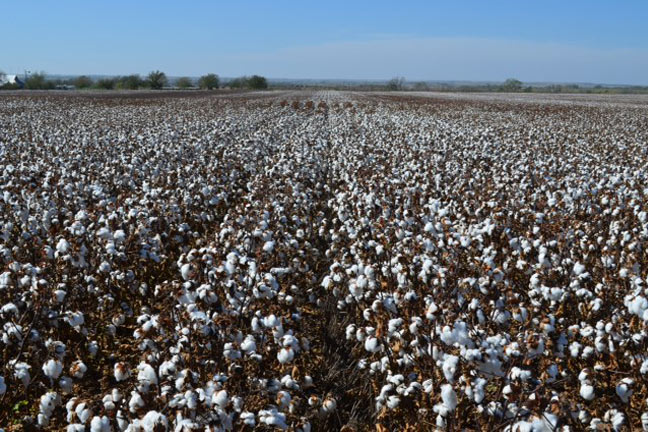
Agricultural News
Oklahoma State University Research Strives to Keep Cotton Competitive in Modern Farming
Tue, 06 Nov 2012 10:46:59 CST

Higher crop prices, increased production costs and rapidly-shifting weather conditions are just a few of the factors farmers must consider when choosing what crops to grow next season. While prices paid to producers for the crops they grow have increased, planting seed, fertilizer to help the crop grow and fuel to keep equipment running have increased in price at an equal pace.
Weather always plays a very important role in crop production; probably the most important factor for dryland farming. Irrigation water supply is dwindling everywhere due to continuing drought and diminishing aquifers while water demands are increasing not only for agricultural production, but for direct human consumption.
In order to survive, producers must choose crops capable of utilizing every drop of moisture while producing top yields of high-quality end products earning the highest price available at harvest.
At no time has there been greater competition between different crops seeking the favor of the producer's checkbook. What to plant each season: winter wheat, grain sorghum, corn, soybeans, canola, cotton and many other choices present producers with difficult choices.
Seeking to make cotton an even more viable choice for Oklahoma producers is the intent of Dr. Randy Boman, Oklahoma State University Research Director and Cotton Extension Program Leader at the OSU Research and Extension Center south of Altus.
Boman has been working with area cotton producers who provide land, equipment and labor to plant cotton he and his team will use for their research. Along with the producers, Boman is working with selected area cotton gin management to obtain important data from the cotton after it has been harvested.
"It is our intention to find which cotton varieties give the highest yields in the field as well as the best fiber quality possible," Boman said. "We are working to help producers choose cotton when they are deciding which crop will make them the most money. What to grow, that is, which crop will make them the most money at harvest has made crop selection highly competitive today especially in light of the run-up in grain and soybean prices."
Boman is obtaining cotton yield and fiber data from cotton planted in several fields across western Oklahoma. One of the cooperators is Merlin Schantz who lives near Hydro. Schantz, who has grown cotton for 40 years, quit farming cotton when excessive insect pressure from boll weevils made growing the crop an expensive proposition.
"After the boll weevil eradication program proved successful, I started growing cotton again," Schantz said. This year, he planted cotton under six pivot irrigation systems as well as dryland cotton.
After harvesting selected cotton variety plots, Boman, along with his staff, Shane Osborne and Larry Bull, used a Lee weigh wagon to take cotton test samples. The wagon is a boll buggy fitted with integral digital scales which enables them to conduct replicated large plot trials.
"Before the cotton is removed from the weigh wagon to be made into modules, we get what we call "grab samples" which are ginned on research equipment and then sent to the Fiber and Biopolymer Research Institute at Lubbock, Texas, for high volume instrument testing of the fiber properties," Boman said. "With assistance from our cooperators and ginners, detailed information is taken when the variety modules are ginned at the Farmer's Cooperative gin at Carnegie. By interpreting this information, we get commercial data on gin turnout, yield and USDA-AMS classing results."
Information available at the Carnegie gin gives Boman "a high quality snapshot of cotton fiber qualities," he said.
Management at the Carnegie gin takes a lot more intricate information from the ginning process through improved computerized technology created by Gin Manager Jeanie Hileman's two ginners, Aaron Hileman and Dalton Skinner. "Both of them have extra math and electronic knowledge which has helped them to program the gin's computers to get extra data for our customers," Hileman said. "We are able to give our customers extra information on their speadsheets so they can see how their cotton is grading and ginning. We can get a better handle on which cotton variety is easier to gin; that is, is it harder to press into a bale and thus, to cost us more energy to do so."
Before the cotton harvest, Boman worked with Schantz and other producer/cooperators across the state to plant replicated agronomic cotton evaluation trials.
"At Merlin's farm, we planted PhytoGen 499 WRF, Deltapine 1219 B2RF, FiberMax 1944 GLB2, Stoneville 4288 B2F, All-Tex Nitro 44 B2RF, Americot 1511 B2RF, NexGen 4012 B2RF and a grower standard for comparison, FiberMax 1740 B2F," Boman said. "We planted three replications of each variety with each variety having eight rows. These rows were planted across a quarter-section field watered with a pivot system. At harvest, Merlin harvested an area 500 feet long of each variety. This cotton was then transferred into the weigh wagon, samples were taken, the remaining cotton for each variety was placed into individual modules, brought to the Carnegie gin and we are getting additional data from the gin's computer now."
Boman and his staff will take this data, along with similar information from other sites, for several more years. He believes facts learned from this research will give valuable information to farmers on what varieties will give them the best results to make cotton more competitive with other crops. Cotton is already known to be a crop that grows well in warm, dry climates. Due to modern genetics, it not only yields top-quality fiber to be milled into cloth; it provides by-products for human and animal consumption as well as for many other needs.
WebReadyTM Powered by WireReady® NSI
Top Agricultural News
More Headlines...




















